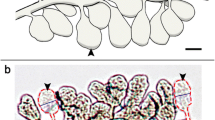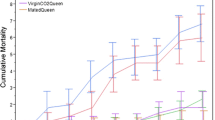Abstract
Most animals can modulate nutrient storage pathways according to changing environmental conditions, but in honey bees nutrient storage is also modulated according to changing behavioral tasks within a colony. Specifically, bees involved in brood care (nurses) have higher lipid stores in their abdominal fat bodies than forager bees. Pheromone communication plays an important role in regulating honey bee behavior and physiology. In particular, queen mandibular pheromone (QMP) slows the transition from nursing to foraging. We tested the effects of QMP exposure on starvation resistance, lipid storage, and gene expression in the fat bodies of worker bees. We found that indeed QMP-treated bees survived much longer compared to control bees when starved and also had higher lipid levels. Expression of vitellogenin RNA, which encodes a yolk protein that is found at higher levels in nurses than foragers, was also higher in the fat bodies of QMP-treated bees. No differences were observed in expression of genes involved in insulin signaling pathways, which are associated with nutrient storage and metabolism in a variety of species; thus, other mechanisms may be involved in increasing the lipid stores. These studies demonstrate that pheromone exposure can modify nutrient storage pathways and fat body gene expression in honey bees and suggest that chemical communication and social interactions play an important role in altering metabolic pathways.


Similar content being viewed by others
References
Amdam GV, Norberg K, Hagen A, Omholt SW (2003) Social exploitation of vitellogenin. Proc Natl Acad Sci USA 100(4):1799–1802
Amdam GV, Csondes A, Fondrk MK, Page RE Jr. (2006a) Complex social behaviour derived from maternal reproductive traits. Nature 439(7072):76–78
Amdam GV, Norberg K, Page RE Jr., Erber J, Scheiner R (2006b) Downregulation of vitellogenin gene activity increases the gustatory responsiveness of honey bee workers (Apis mellifera). Behav Brain Res 169(2):201–205
Beggs KT, Glendining KA, Marechal NM, Vergoz V, Nakamura I, Nakamura I, Slessor KN, Mercer AR (2007) Queen pheromone modulates brain dopamine function in worker honey bees. Proc Natl Acad Sci USA 104(7):2460–2464
Broughton SJ, Piper MD, Ikeya T, Bass TM, Jacobson J, Driege Y, Martinez P, Hafen E, Withers DJ, Leevers SJ, Partridge L (2005) Longer lifespan, altered metabolism, and stress resistance in Drosophila from ablation of cells making insulin-like ligands. Proc Natl Acad Sci USA 102(8):3105–3110
Corona M, Velarde RA, Remolina S, Moran-Lauter A, Wang Y, Hughes KA, Robinson GE (2007) Vitellogenin, juvenile hormone, insulin signaling, and queen honey bee longevity. Proc Natl Acad Sci USA 104(17):7128–7133
Finch CE, Ruvkun G (2001) The genetics of aging. Annu Rev Genomics Hum Genet 2:435–462
Flatt T, Tu MP, Tatar M (2005) Hormonal pleiotropy and the juvenile hormone regulation of Drosophila development and life history. Bioessays 27(10):999–1010
Fluri P, Luscher M, Wille H, Gerig L (1982) Changes in the weight of the pharyngeal gland and haemolymph titres of juvenile hormone, protein and vitellogenin in worker honey bees. J Insect Physiol 28:61–68
Giannakou ME, Partridge L (2007) Role of insulin-like signalling in Drosophila lifespan. Trends Biochem Sci 32(4):180–188
Grozinger CM, Robinson GE (2007) Endocrine modulation of a pheromone-responsive gene in the honey bee brain. J Comp Physiol A Neuroethol Sens Neural Behav Physiol 193(4):461–470
Grozinger CM, Fischer P, Hampton JE (2007) Uncoupling primer and releaser responses to pheromone in honey bees. Naturwissenschaften 94(5):375–379
Grozinger CM, Sharabash NM, Whitfield CW, Robinson GE (2003) Pheromone-mediated gene expression in the honey bee brain. Proc Natl Acad Sci USA 100(Suppl 2):14519–14525
Guidugli KR, Nascimento AM, Amdam GV, Barchuk AR, Omholt S, Simoes ZL, Hartfelder K (2005) Vitellogenin regulates hormonal dynamics in the worker caste of a eusocial insect. FEBS Lett 579(22):4961–4965
Harbison ST, Chang S, Kamdar KP, Mackay TF (2005) Quantitative genomics of starvation stress resistance in Drosophila. Genome Biol 6(4):R36
Harbison ST, Yamamoto AH, Fanara JJ, Norga KK, Mackay TF (2004) Quantitative trait loci affecting starvation resistance in Drosophila melanogaster. Genetics 166(4):1807–1823
Hughes KA, Reynolds RM (2005) Evolutionary and mechanistic theories of aging. Annu Rev Entomol 50:421–445
Hwangbo DS, Gershman B, Tu MP, Palmer M, Tatar M (2004) Drosophila dFOXO controls lifespan and regulates insulin signalling in brain and fat body. Nature 429(6991):562–566
Pankiw T, Page RE Jr (2003) Effect of pheromones, hormones, and handling on sucrose response thresholds of honey bees (Apis mellifera L.). J Comp Physiol A Neuroethol Sens Neural Behav Physiol 189(9):675–684
Pankiw T, Waddington KD, Page RE Jr. (2001) Modulation of sucrose response thresholds in honey bees (Apis mellifera L.): influence of genotype, feeding, and foraging experience. J Comp Physiol [A] 187(4):293–301
Pankiw T, Huang Z, Winston ML, Robinson GE (1998) Queen mandibular gland pheromone influences worker honey bee (Apis mellifera L.) foraging ontogeny and juvenile hormone titers. J Insect Physiol 44(7–8):685–692
Pinto LZ, Bitondi MM, Simoes ZL (2000) Inhibition of vitellogenin synthesis in Apis mellifera workers by a juvenile hormone analogue, pyriproxyfen. J Insect Physiol 46(2):153–160
Robinson GE, Vargo EL (1997) Juvenile hormone in adult eusocial Hymenoptera: gonadotropin and behavioral pacemaker. Arch Insect Biochem Physiol 35(4):559–583
Schulz DJ, Huang Z, Robinson GE (1998) Effects of colony food shortage on behavioral development in honey bees. Behav Ecol Sociobiol 42(5):295–303
Seehuus SC, Norberg K, Gimsa U, Krekling T, Amdam GV (2006) Reproductive protein protects functionally sterile honey bee workers from oxidative stress. Proc Natl Acad Sci USA 103(4):962–967
Slessor KN, Winston ML, Le Conte Y (2005) Pheromone communication in the honeybee (Apis mellifera L.). J Chem Ecol 31(11):2731–2745
Sullivan JP, Fahrbach SE, Harrison JF, Capaldi EA, Fewell JH, Robinson GE (2003) Juvenile hormone and division of labor in honey bee colonies: effects of allatectomy on flight behavior and metabolism. J Exp Biol 206(Pt 13):2287–2296
Toth AL, Robinson GE (2005) Worker nutrition and division of labour in honeybees. Animal Behavior 69(2):427–435
Toth AL, Kantarovich S, Meisel AF, Robinson GE (2005) Nutritional status influences socially regulated foraging ontogeny in honey bees. J Exp Biol 208(Pt 24):4641–4649
Vergoz V, Schreurs HA, Mercer AR (2007) Queen pheromone blocks aversive learning in young worker bees. Science 317(5836):384–386
Whitfield CW, Cziko AM, Robinson GE (2003) Gene expression profiles in the brain predict behavior in individual honey bees. Science 302(5643):296–299
Acknowledgments
We would like to thank Professor Cavell Brownie for statistical advice, Joe Flowers for expert beekeeping assistance, Dr. Yongliang Fan for assistance with qRT-PCR experiments, members of the Grozinger lab for helpful discussions, and Gene Robinson, Amy Toth, and Seth Ament for critical reading of the manuscript. This work was supported by an NIH-NIDCD grant (1 R01 DC006395-01A1) to G.E. Robinson (subaward to CMG). These experiments comply with the laws of the USA.
Author information
Authors and Affiliations
Corresponding author
Rights and permissions
About this article
Cite this article
Fischer, P., Grozinger, C.M. Pheromonal regulation of starvation resistance in honey bee workers (Apis mellifera). Naturwissenschaften 95, 723–729 (2008). https://doi.org/10.1007/s00114-008-0378-8
Received:
Revised:
Accepted:
Published:
Issue Date:
DOI: https://doi.org/10.1007/s00114-008-0378-8




